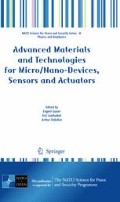Abstract
For almost 50 years, silicon sensors have been on the market. There have been many examples of success stories for simple silicon sensors, such as the Hall plate and photo-diode. These have found mass-market applications. The development of micromachining techniques brought pressure sensors and accelerometers into the market and later the gyroscope. These have also achieved mass-market. The remaining issue is how far to integrate. Many of the devices on the market use a simple sensor with external electronics or read-out electronics in the same package (system-in-a-package). However, there are also many examples of fully integrated sensors (smart sensors) where the whole system is integrated into a single chip. If the application and the device technology permit this, there can be many advantages. A broader look at sensors shows a wealth of integrated devices. The critical issues are reliability and packaging if these devices are to find the applications. A number of silicon sensors and actuators have shown great commercial success, but still many more have to find their way out of the laboratory. This paper will examine the development of the technologies, some of the success stories and the opportunities for integrated Microsystems as well as the pitfalls.
Access this chapter
Tax calculation will be finalised at checkout
Purchases are for personal use only
References
K.E. Bean, Anisotropic etching of silicon, IEEE Trans Electron Devices, ED-25, (1978), pp. 1185–1193.
H.C. Nathanson and R.A. Wickstrom, A resonant-gate silicon surface transistor with high-Q band pass properties, Appl. Phys. Lett., 7, (1965), p. 84.
R.T. Howe and R.S. Muller, Polycrystalline and amorphous silicon micromechanical beams: annealing and mechanical properties, Sensors and Actuators, 4, (1983), pp. 447–454.
L-S. Fan, Y-C. Tai and R.S. Muller, Pin joints, gears, springs, cranks and other novel micromechanical structures, Proceedings Transducers 87, Tokyo, (1987), pp. 849–852.
V. Lehman, Porous silicon – a new material for MEMS, Proc. IEEE MEMS Workshop ’96, San Diego, USA (1996) pp. 1–6.
H. Ohji, P.J. Trimp and P.J. French, Fabrication of free standing structures using a single step electrochemical etching in hydrofluoric acid, Sensors and Actuators, A: Physical 73 (1999) pp. 95–100.
H. Ohji, P.J. French and K. Tsutsumi, Fabrication of mechanical structures in p-type silicon using electrochemical etching, Sensors and Actuators A: Physical 82 (1–3) (2000) pp. 254–258.
G. Craciun, M. Blauw, E. van der Drift and P.J. French, “Aspect ratio and crystallographic orientation dependence in deep dry silicon etching at cyrogenic temperatures”, Proceedings Transducers 01, Munich Germany, June 2001.
F.Laemer, A.Schilp, K.Funk, M.Offenberg, Bosch deep silicon etching: improving uniformity and etch rate for advanced MEMS applications, Proc. IEEE MEMS 1999 Conf., Orlando, FL, USA (1999).
C. Hierold, A. Hilderbrandt, U. Näher, T. Scheiter, B. Mensching, M. Steger and R. Tielert, A pure CMOS surface micromachined integrated accelerometer, Proceedings MEMS 96, San Diego, USA 1996, pp. 174–179.
G.K. Fedder, S. Santhanan, M.L. Read, S.C. Eagle, D.F. Guillou, M.S.-C. Lu and L.R. Carley, Laminated high-aspect ratio microstructures in a conventional CMOS process, Proceedings MEMS 96, San Diego, USA, Feb 1996, pp. 13–18.
J.H. Smith, S. Montague, J.J. Sniegowski, J.R. Murray, R.P. Manginell and P.J. McWhorter, “Characterisation of the embedded micromachined device approach to the monolithic integration of MEMS with CMOS”, Proceedings SPIE Micromachining and Microfabrication Process Technology II, Austin, Texas, USA, October 1996, vol 2879, pp. 306–314.
Y.B. Gianchandani, M. Shinn and K. Najafi, “Impact of long high temperature anneals on residual stress in polysilicon”, Proceedings Transducers’97, Chicago, USA, June 1997, pp. 623–624.
B.P. van Drieënhuizen, J.F.L. Goosen, P.J. French, Y.X. Li, D. Poenar and R.F. Wolffenbuttel, Surface micromachined module compatible with BiFET electronic processing, Proceedings Eurosensors 94, Toulouse, France, September 1994, p. 108.
J.M. Bustillo, G.K. Fedder, C.T.-C. Nguyen and R.T. Howe, Process technology for the modular integration of CMOS and polysilicon microstructures, Microsystem Technology, 1, (1994), pp. 30–41.
L S Pakula, H Yang, H T M Pham, P J French and P M Sarro, “Fabrication of a CMOS compatible pressure sensor for harsh environments”, J. Micromech. Microeng., 14, (2004), pp. 1478–1483.
H. Yang, L. Pakula and P.J. French, “A novel operation mode for accelerometers”, Proceedings Pacific Rim Workshop on Transducers and micro/nano technologies, Xiamen, China 22–24 July 2002, pp. 303–306.
A. Bakker, J.H. Huijsing, “A CMOS spinning-current Hall effect sensor with integrated submicrovolt offset instrumentation amplifier”, SAFE99 proceedings (ISBN: 90-73461-18-9), Mierlo, Nov. 1999, pp. 17–20.
A. Bakker, “High-accuracy CMOS smart temperature sensors” PhD thesis, TU Delft, The Netherlands, 2000, 132 p. ISBN: 90-901-3643-6.
A. Bakker, J.H. Huijsing, “CMOS smart temperature sensor with uncalibrated 1oC accuracy”, Proceedings ProRISC, 26–27 November 1998, Mierlo, The Netherlands, pp. 19–22.
K.A.A. Makinwa and J.H. Huijsing, “A smart CMOS wind sensor”, Solid-State Circuits Conference, 2002. Proceedings. ISSCC. 2002 Volume 2, Issue, 2002 Page(s):352–544.
Acknowledgements
The author would like to thank many colleagues in DIMES for their input, the Dutch Science Foundation STW for their sponsoring of many of the work performed in Delft and also the colleagues around the world who have given permission to use figures.
Author information
Authors and Affiliations
Corresponding author
Editor information
Editors and Affiliations
Rights and permissions
Copyright information
© 2010 Springer Science+Business Media B.V.
About this paper
Cite this paper
French, P.J. (2010). Smart Sensors: Advantages and Pitfalls. In: Gusev, E., Garfunkel, E., Dideikin, A. (eds) Advanced Materials and Technologies for Micro/Nano-Devices, Sensors and Actuators. NATO Science for Peace and Security Series B: Physics and Biophysics. Springer, Dordrecht. https://doi.org/10.1007/978-90-481-3807-4_20
Download citation
DOI: https://doi.org/10.1007/978-90-481-3807-4_20
Published:
Publisher Name: Springer, Dordrecht
Print ISBN: 978-90-481-3805-0
Online ISBN: 978-90-481-3807-4
eBook Packages: Physics and AstronomyPhysics and Astronomy (R0)

